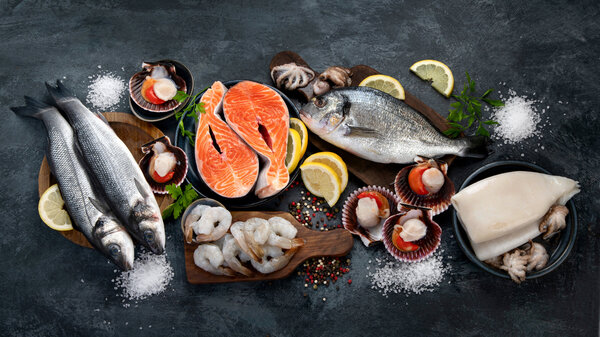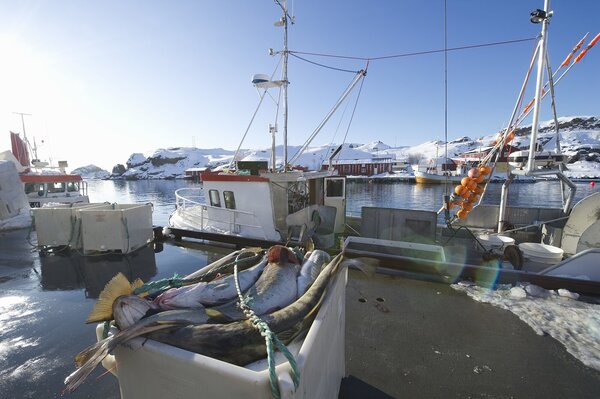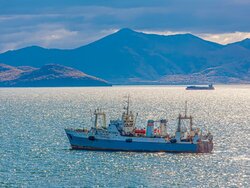Expertise
EU counter-tariffs would hit the fishing industry hard
Christopher Zimmermann | 15.04.2025
Germany exports a lot of processed salmon from aquaculture to the USA. Nevertheless, punitive tariffs would be less severe than expected counter-tariffs from the EU. This is because imports of white fish (especially Alaskan pollack) and wild salmon from the USA are much more important for the German market. There is a considerable trade deficit in fish products in favour of the USA.

Like timber and agricultural products, exports of fish and seafood are also directly affected by the threat of punitive tariffs imposed by the USA. The numbers given here are summarised values for the past five years (2020-2024), since the fluctuations between the individual years due to the coronavirus pandemic, Ukraine war and sanctions are high and could distort the picture.
Exports to the USA: processed salmon from aquaculture
The USA has purchased fish and fishery products worth 477 million euros from Germany in the past five years. 15 per cent of this was accounted for by processed products. Salmon is the most frequently imported fish species from Germany, accounting for 83 per cent or 397 million euros of the trade volume. The majority of this was Atlantic salmon from Norwegian aquaculture, which was processed and refined in Germany. Pacific salmon imported from the USA is also exported back to the USA as a processed product. Other important fish exports from Germany to the USA are canned goods (mainly canned herring), which account for ten per cent or 49 million euros of the trade volume, and caviar/fish eggs, which account for 14 million euros or three per cent.
The export volume from the EU countries to the USA totalled 4.9 billion euros in the five-year period previously mentioned. 81 per cent of the exported goods were unprocessed fish. Salmon and salmon products accounted for 51 per cent. Molluscs (mussels and squid, especially octopus), sea bass and canned small schooling fish (herring, mackerel, sardines) are also of considerable importance.
Imports from the USA: Alaska pollack and wild salmon

The supply of raw materials, especially Alaska pollack (Gadus chalcogrammus), is of paramount importance to the German fishing industry. Up to 80 per cent of imports of Alaska pollack now come from Russian fisheries and often from Chinese primary processing – despite the war, these quantities of fish are irreplaceable, as there are no other sources for such quantities of white fish. However, the German industry, which is home to the world's largest fish finger production, obtains 18 per cent of its raw materials from fisheries off Alaska. Germany alone purchases half of the EU's imports of Alaskan pollack. Even this quantity is still far too large to be replaced by other sources. In addition, the US fishery should have no problems selling its Alaska pollack raw material to markets other than Europe.
The same applies to wild salmon: most of the wild salmon on the German market presumably comes from the USA via China, with the second largest share coming directly from the USA and smaller quantities from Russian and Canadian fisheries. US wild salmon cannot be substituted. However, unlike Alaska pollack, the European market is essential for the commercialisation of high-priced wild salmon. Especially in years with good catches, it could be difficult or expensive for the US fishery to sell this product elsewhere.
Other important species are hake and lobster/Norway lobster/spiny lobster. After Canada and China, the EU is the third most important buyer of fish and fishery products from the USA. Conversely, the USA has been the fourth most important importing country for these goods into the EU in the past five years after China, Vietnam and Norway.
Between 2020 and 2024, Germany imported a total of 793 million euros worth of fishery products from the USA. Unprocessed products alone accounted for 764 million euros or 96 per cent of this amount. Alaska pollock accounted for the largest share at 492 million euros or 62 per cent, followed by wild salmon at 157 million euros (20 per cent). Other important products (in decreasing importance): Caviar/fish eggs, fish livers, hake, flatfish and shark products.
The situation is similar for the EU: imports from the USA totalled 4.0 billion euros in the five years mentioned. 95 per cent of this was unprocessed fish. 48 per cent of the trade volume was accounted for by Alaska pollack, 18 per cent by salmon (wild and aquaculture), seven per cent each by hake and lobster, followed by fish livers, shrimps, cod and squid.
The trade balance for fishery products with Germany between 2020 and 2024 totalled 316 million euros in favour of the USA, while the trade balance with the EU totalled 933 million euros in favour of the EU.







